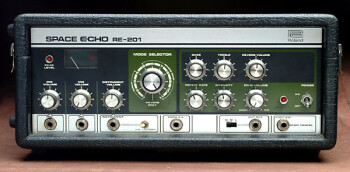This week we'll look into a somewhat particular use of delay ─ as a way of filling up a mix. You certainly won't be able to use this technique every day, but it can come in pretty handy to "dress up" stripped-down productions or songs with slow tempos.
Dress it up
Our goal today is to create a clearly audible echo effect. And to do that you need to create an aux bus and insert a delay with the following settings:
- A long delay time that’s synced to the tempo ─ at least to the sixteenth note
- A good deal of feedback to get a lot of of repetition
In addition, adjust the tone of the delay, using the EQ options of your delay plug-in, to help differentiate the successive repetitions. This will give the final result a more lively aspect
Once this bus has been setup, send to it the signal of the track you want to “dress up, ” like the vocals or a solo instrument. The only problem with this effect is that it might turn out to be too intrusive, so consider having it come up only during those parts that actually need it. Fortunately, there are different ways to achieve that. You could, for instance, use automation, which is something we’ll discuss soon enough. Or you could also use a noise gate with a ducking function. Setting this up is easy. Just place the gate right before the delay plug-in on the aux bus, activate the ducking option and feed the sidechain with the source signal. If you setup the gate correctly, you should be able to make the echo effect only show up when the processed signal isn’t present. This way it will not cloud all the song, but rather fill the gaps left by the original signal.
I want to mention a couple of more points before I finish. First, I guess you are aware of the fact that’s it’s not the best idea to use this technique on several elements at the same time. That would be counterproductive, producing a mush that’s far from the elegant and subtle filling effect you are aiming for.
I do recommend you to systematically use an EQ at the output of this delay bus to avoid it getting in the way of the rest of the mix. After all, it’s not meant to steal the show, its goal is simply to fill up certain parts that are somewhat empty in order to make the overall result nicer and, especially, more musical.
Finally, don’t hesitate to play with the delay time to make it better match the groove of the song. Or you could even make it lag behind a bit, a couple of milliseconds only, to create a sense of “groovy heaviness” or make it play slightly ahead of the tempo, to give the song a surge of liveliness. Along the same lines, you can explore the ping-pong effect, if your plug-in features this option. This could be interesting from a rhythmic point of view even if the transparency of the effect becomes a bit debatable.
Next week we’ll close the delay chapter by discussing the use of reverb and delay, together.

